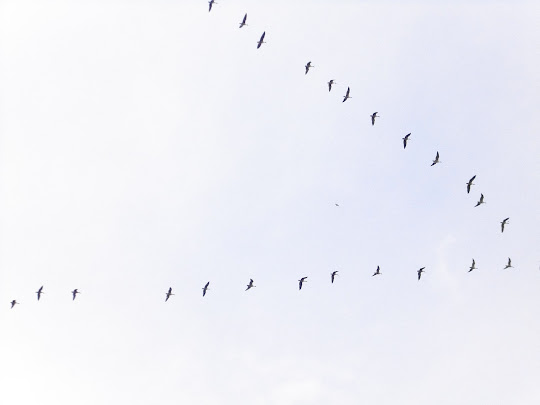The pinkfeet, or simply ‘pinks’, begin to arrive in the first weeks of September. The main influx is in early October, and by the end of that month they are pretty well all here and will remain till mid-April or early May.
Our birds breed in Greenland and Iceland; another, discrete, population, wintering on the Continent, breeds at Svalbard and Novaya Zemlya. They nest on cliffs as protection against such predators as arctic foxes; after hatching, the goslings walk with their parents to the nearest lake, where they spend the next couple of months.
Thanks to a diminution in winter shooting, the Pink-footed Goose has seen a spectacular increase in numbers. More than half a million now arrive in Britain each autumn, and north Norfolk is one of their principal wintering grounds. The birds are drawn here by the relative mildness of the climate, the vast stretch of unspoilt coast between Sheringham and the Wash, and above all by the opportunities for grazing farmers’ fields.
In this they provide both a benefit and a disbenefit. Besides various grasses, such as winter wheat, they have a taste for oilseed rape and the leaves of potato and sugar beet. A large flock descending on a field can ruin a crop within just a few hours. However, by gleaning leaves and roots left behind after harvesting, they reduce the transmission of plant diseases from one year to the next, and their droppings, or ‘mutes’, do help to fertilise the soil.
Image credit: Duncan Brown; licence
A big flock taking flight with a roar of wings is an impressive sight. One of the biggest gatherings ever recorded was at the Loch of Strathbeg in Aberdeenshire, where 66,000 passage birds had assembled in September 2003. From a broad beet field between Langham and Saxlingham, one December day, 6,000+ pinkfeet rose almost as one body on seeing a stroller get too close: fifteen tons of avian biomass, perfectly co-ordinated. While their brethren are feeding, a few geese take turns as sentries. Their eyesight is sharp, and they are very suspicious.
The aerodynamics of the V-formations assumed in flight by pinkfeet, and indeed many other large, social birds, such as gulls, have recently been elucidated. The birds position themselves with respect to the bird in front to minimise the labour of flying. A flexing wingtip produces an ‘upwash’ of air. By synchronising its own wingbeats with those of the bird in front, the bird behind exploits this upwash and in effect gets a partially free ride.
If one bird flew directly behind another, phase effects would make its flight more strenuous. The angle of the V is critical, and birds 2 and 3 in the formation determine the positions of all the others. The Vs are often lopsided, and can be disrupted by gusts of wind; even so, such flight enables the pinkfeet to make the thousand-mile journey here from Iceland in a matter of a few days, stopping off to feed and rest perhaps at the Faeroes, Shetland, mainland Scotland, or the northern English coasts.
No one has yet understood how birds know where to position themselves to maximise the benefits of V-formation flight. It is as if they can ‘see’ the air-currents. What’s more, on different days they commute at different heights, probably dictated by thermal activity or changes in atmospheric pressure.
Nor is it understood how they choose which field to feed upon. The leading bird may decide. They do not land directly, but circle for a while to make sure all is well. Then the boldest few geese alight, and with a falling, fan-like motion the rest of the flock follows. At first their heads are held high and they look warily around, but presently, reassured, they begin to feed.


No comments:
Post a Comment
Please remember to be polite. Any comment with incendiary content will not make it through moderation.